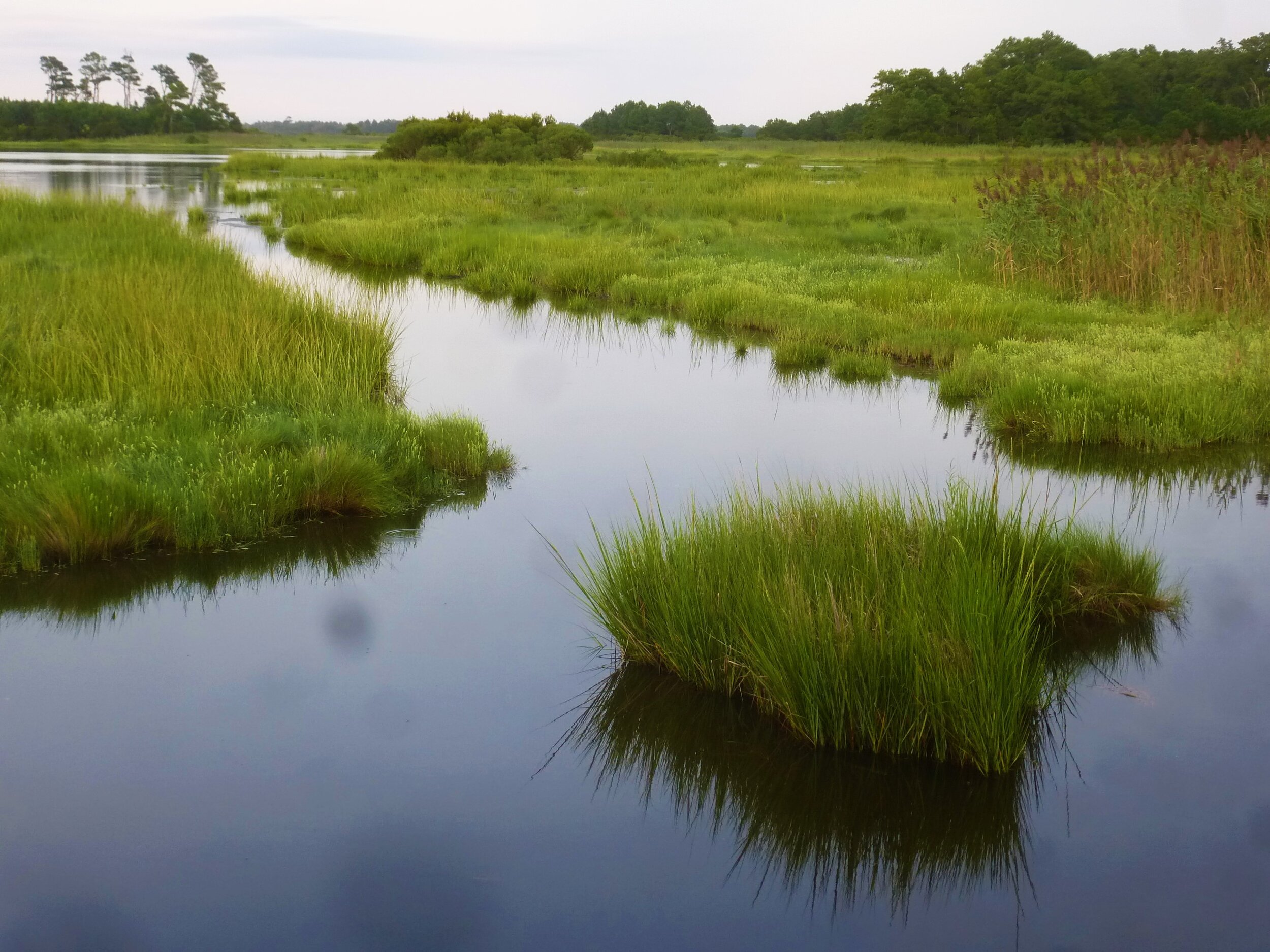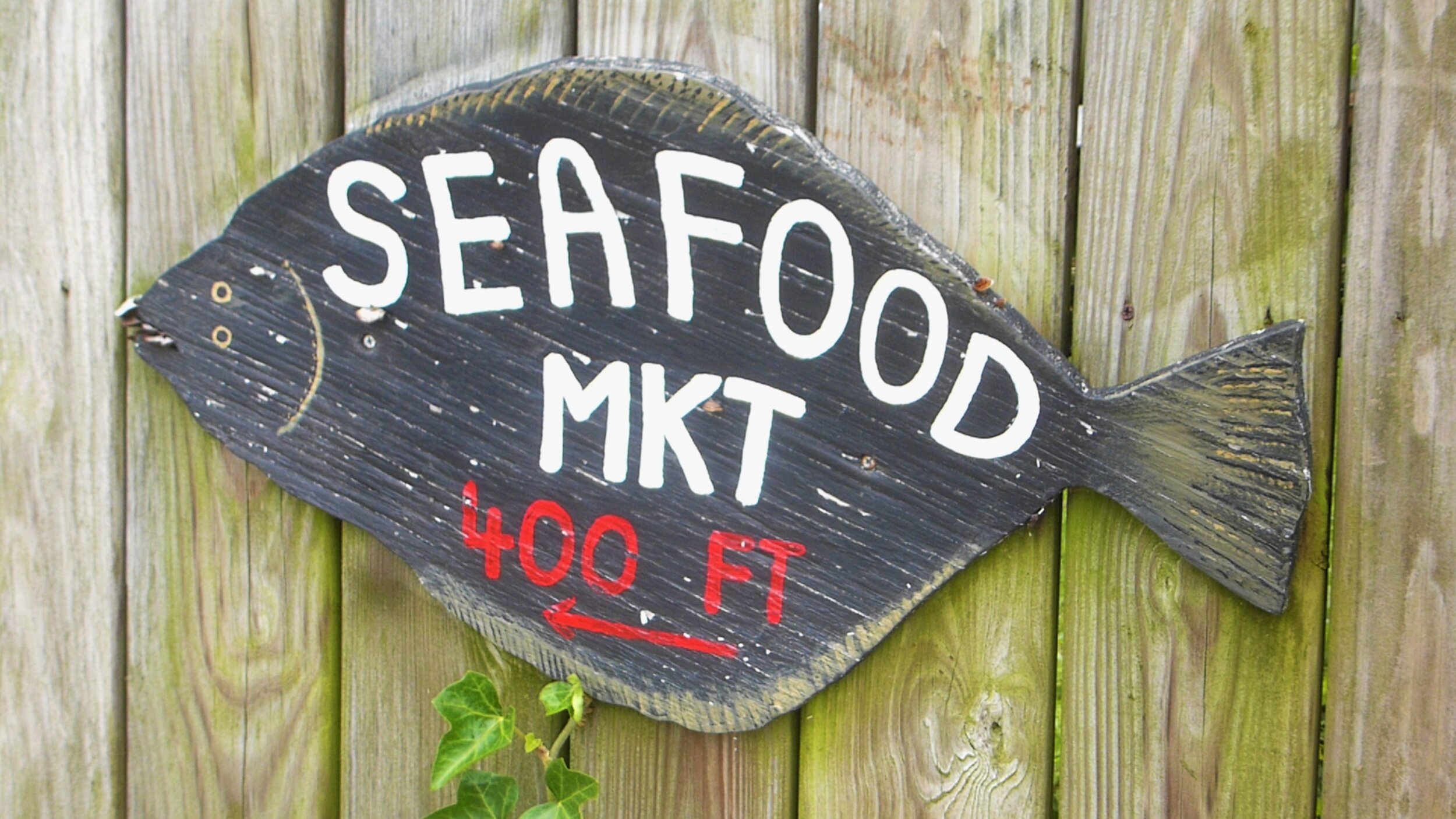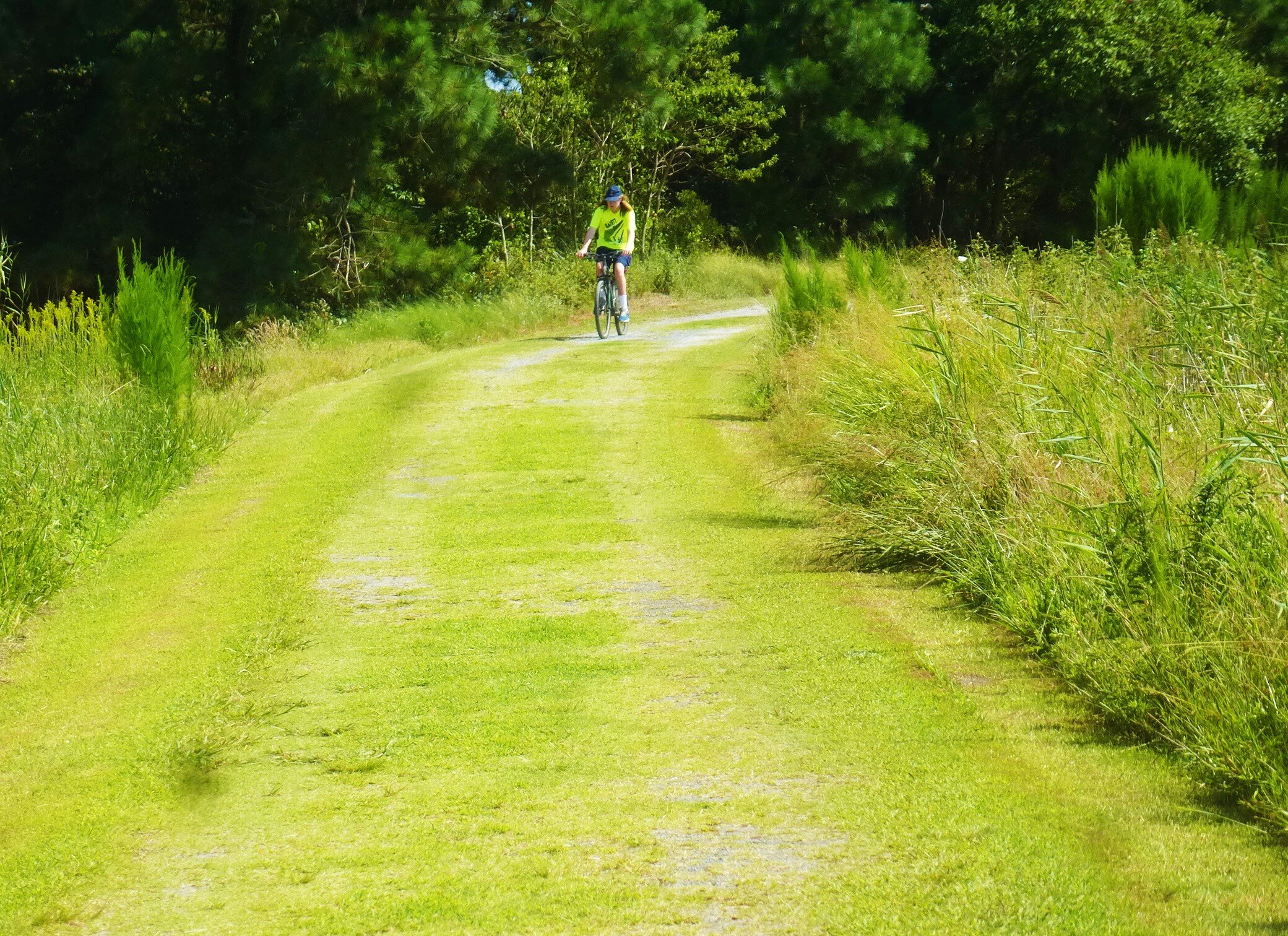
Chincoteague and Assateague: A Delicate Balance
by Charles McGuigan 09.2021
Islanders are a rare breed, from those who inhabit places like Vinalhaven off the coast of Maine, to Ocracokers, to the denizens of the more remote Florida Keys, still unspoiled by excessive development. All these folks seem to possess a strong sense of individualism, but at the same time, perhaps because of the closeness that islands by their very geography dictate, are also inextricably united, and work together toward a common good. This, too: due to the palpable limits of natural resources, these island people adamantly protect the very nature that permits them to live and work within these fragile ecosystems, and they manage their fisheries like doting parents. This is all true of those who call Chincoteague and Assateague home.
Submerged work boat near the southern end of Main Street on Chincoteague.
We had tried to get out of town for three days, but just as we were on the verge of departing another obstacle prevented us from doing so. Finally, on a clear Wednesday morning, with our CRV loaded to the hilt, my son Charles and I made our way down 64, and then, to skirt a traffic standstill, dropped over to old Route 60, reconnected to the interstate just below Williamsburg, crossed Hampton Roads, rocketed over and under Chesapeake Bay, travelled at a comfortable speed up the Eastern Shore of Virginia along Lankford Highway (Route 13), and took a sharp right on Chincoteague Road at T’s Corner, and at last the rush seemed over as we drove through dense stands of pines and hardwoods, across vast fields of corn and soybean, past farmhouses and a few scattered villages, flanked by NASA’s giant satellite dishes on Wallops Island, and just after the road took a sharp curve to the right, the world opened up to a vast expanse of salt marshes and inlets and creeks that spread as far to the east as the horizon and to the north and south as far as our eyes could see.
And then we crossed Mosquito Creek, breaking away from the mainland of the Eastern Shore, but it wasn’t until we reached the next creek that I pulled off to the shoulder so that Charles and I could stretch and view the watery world that would be our home for the next five days, so that we could inhale the salty iodine air laced with the sweet bitterness of sea decay and marsh grasses. We climbed over the guardrail and made our way up the bank until we could look directly into a wide creek where the tide was streaming out at a furious rate, and where we could see fish lines on the surface running counter to the tide.
This was Cockle Creek, and there was an extremely important, and unusual, battle fought here during the war that tested the resolve of the great American Experiment. Though by the standards of a war that would eventually claim the lives of 600,000 men, it might have seemed like a minor skirmish, the Battle of Cockle Creek destroyed the enemy’s attempt to control Delaware Bay, and strengthened our country’s dominance over the entire Delmarva Peninsula.
In 1861, not long after Virginia seceded from the Union, Chincoteague Islanders refused to do so, choosing instead to remain loyal to the United States. Islanders, in a 138 to 2 vote, refused to secede, the sole section of the Commonwealth to do so.
On July 4 of the same year, 418 men from the barrier islands of Maryland and Virginia met on Chincoteague to celebrate the 85th anniversary of American independence. Those present signed a document pledging support for the United States against its enemies. One of them, a War of 1812 veteran, shouted, "I will defend the old flag to my last drop of blood, against the lazy, slave-holding aristocrats and their lackeys in Richmond." Oh noble islanders!
As that summer came to a close, General Winfield Scott, the sort of de facto commander of Union forces, recommended several thousand troops be sent to protect the Chincoteague Islanders.
Fresh seafood is available all over Chincoteague, frequently out of someone's garage.
In the early fall, three ships anchored along Cockle Creek. One of them, which had earlier flown the Union Jack, suddenly raised the Confederate ensign. An oyster sloop piloted by an Islander sailed down to Hampton Roads to notify the Union Navy. A couple days later, the USS Louisiana, a propeller-driven, iron-hull steamer, arrived.
On October 5, two boats launched from the Louisiana attacked one of the three ships. When about 300 Confederates tried to cut off the two boats launched by the Louisiana, the Union response was fierce. Within hours the Confederate defenses were crushed. One of the Confederate vessels was scuttled, the other two captured. When Winfield Scott received the news, he ordered a large plate of Chincoteague oysters at The Willard Hotel in Washington. By early December, 4,000 Federal troops secured the entire Eastern Shore of Virginia.
As we return to the car, Charles spots a group of American oystercatchers, standing on stilted legs atop a sandbar, their bright orange bills like signal lights. “Just like the ones we saw that winter down in Key West,” Charles says. “Remember, all lined up on the beach at that old fort.”
“Zachary Taylor?”
“That’s the one.”
“I remember.”
We cross the remainder of the four-mile long John B. Whealton Memorial Causeway, its small bridges spanning channels of Chincoteague Bay, its roadway carving a narrow swath through marsh islands of spartina, fiddler crabs, birds and mud.
Our house, which is owned by a neighbor in Ginter Park, is a lovely two-story Eastern Shore farmhouse with ample room, and a cozy feel. It’s located off Chicken City Road in the section of the island known as Deep Hole.
After settling in, we explore the southern tip of the island, check out a small fishing pier there and then make our way over to Assateague, and are immediately drawn in by the abundant wildlife. We hike the beach all the way down to the southern tip of this barrier island, well beyond the Coast Guard Station, to the Assateague Hook, which is shaped exactly like the barbed head of a whaling harpoon. The surf is turbulent and choppy, the aftermath of a hurricane, and a warm and constant wind blows directly out of the east urging along chunks of spume that cover the beach in an uninterrupted line just above the wrack zone. We spy several ghost crabs, and in the retreating waves scoop out handfuls of immature mole crabs (though we always called them sand fleas) that wriggle through the sand in your clenched palm and you can feel their tiny appendages flick at your skin.
That night we drop by Captain Zack’s Seafood, a locally owned and operated seafood shack for pickup only that serves up some of the best salt oysters I’ve ever eaten. Over the next few days it will become our go-to place for dinner, and we’ll sample their offerings in one form or another, whether steamed, or fried in a lightly breaded cornmeal and flour mix.
There is no finer oyster in all the world than those that come out of the seaside of Chincoteague Island. When you bite into one, as your molars crush the tender meat, there is an explosion of flavor unlike anything else you will ever eat.
Jenny Sommers, who owned the Bayside Retreat on Main Street, told me more than a little about the island and its oysters a couple years ago as we sat on her front porch on a lazy afternoon in late August.
“I’ve told people on the mainland that I can tell if that oyster comes from the seaside or the bayside of Chincoteague,” she told me, and then considered the seaside oysters. “It’s like biting the ocean,” she said. “I’m an oyster baby and always have been. I can eat my weight in oysters.”
Biking the wildlife loop around Snow Goose Pool.
Jenny could trace her familial roots all the way back to that time that the English stole the lands from the native peoples. “My people have been here since 1665,” she told me. A lot of settlers that came to our country were transported people. Most people aren’t going to claim it; I have no problem with it. They may have been transported because they were political prisoners. They may have been transported because their family was starving and they stole a loaf of bread or they poached some animal in the forest.”
Her ancestors were indentured to a ruthless landowner Colonel Daniel Jennifer who worked his charges like slaves. “He transported about twenty-five indentured men, but no women,” Jenny said. “The native people in this area were Gingoteague and Akessateague and they were part of the Nantikoke people, members of the Algonquin nation. The men who were transported to these islands frequently married native people, so I have the blood of native people in my veins, and I’m proud of that fact.”
Chincoteague, incidentally, means “beautiful land across the water”; while Assateague means “swiftly moving water”.
The next morning after a late breakfast, Charles and I drive over to Assateague and park the car in the first lot and unload our bikes then pedal along the Wildlife Loop with a detour on the Marsh Trail, and then out Swan Cove Trail to a narrow beach access through the dunes.
On the Marsh Trail we see a number of white tail deer and red foxes. In the pool at its center we see a five-foot cottonmouth, its thick body slithering rapidly on the surface of the water, effortless in its buoyancy like the modelling balloon a magician might twist into a dachshund. We also spot two diamondback terrapins, and one river otter, which is a real treat to watch.
Oysters and clams are on the menu that second night, and after a late dinner Charles goes to sleep and I venture onto the back porch and am quickly sheathed in a second skin of jet black mosquitos that immediately turn blood red when I wipe them away with a flattened palm, as I make my way back inside. Then I douse all the outside lights, pull on a pair of jeans and a long-sleeved shirt and return to the porch where I am immediately bathed in the soothing harmonics of a thousand tree frogs frantic for mates, while overhead, framed by the limbs of the three maples in the backyard, the Milky Way seems to pulse with a silent timbre that is detected not by my the ears but by every cell within me. It is a good thing to go to sleep with.
Mare and her foal.
My daughter, Catherine, and her boyfriend, Matt, are to join us late the next afternoon, so Charles and I spend a good part of the day fishing from the municipal pier at the city square on Main Street and then out to Veteran’s Memorial Park near Tom’s Cove Aquafarms. Charles catches a two-pound croaker, and a bait-sized black sea bass, both of which we lovingly release and throw back. After a brief lunch we head back over to Assateague and hike the trail out to the Assateague Lighthouse.
Assateague Island is a vast seaside island (about 50,000 acres) that runs alongside the eastern shores of both Maryland and Virginia. Like all the barrier islands in Virginia’s chain, Assateague is restless, forever on the move, nomadic.
As a matter of fact, up until about 1800, Chincoteague was a barrier island unto itself. But then Assateague began a southward migration, as Chincoteague moved westward. Assateague seemed to wrap her protective arm around Chincoteague to shield her smaller sister from the ravages of the wild Atlantic.
Catherine and Matt don’t arrive until much later in the evening. We spend most of the next day over on Assateague, and Catherine, an artist and environmental scientist says this, as we are looking across a vast expanse of spartina with occasional hammocks supporting small stands of loblollies: “It looks like the Serengeti.”
And she’s right. You half expect to see a lion slinking through the grasses, or wildebeest stampeding across the marshlands. Instead we see the wild horses, the ponies with their salt-bloated bellies, grazing contentedly on cordgrass and black needle rush and saltwort. We even spot, among the herd, a mare and her foal.
The islands and surrounding salt marshes and bays are home to hundreds of different species of animals—amphibians, reptiles, mammals and birds galore. In the next couple hours we will see whimbrels, common terns, great blue herons, willets, along with a single green heron, and one great white egret, standing amid the spartina stabbing at the water for its dinner.
These bays and the surrounding salt marshes are a breeding ground for all the bounty of the sea, from blue crabs to summer flounder. Oysters, which have made a terrific comeback here, filter the nutrient rich waters that are created by the saltmarsh grasses.
Aquaculture has been practiced on Chincoteague for generations out of mind. That’s what Jenny had told me a couple years back. She had told me about Tom’s Cove Aquafarms near Black Point Landing which specializes in oysters and cherrystone clams.
“You harvest the oysters off oyster rocks and deepwater beds,” she said. “My family had a deepwater bed at Mosquito Creek and we had oyster rocks up the creek beyond the new bridge behind the island.”
They also had clam beds just across the marsh from her girlhood home. “My daddy would go out to Wallops Island in the early summer,” Jenny remembered. “We’d go out with the big scow and we’d pick up baby clams.” The clams were plentiful as coquinas in the surf. “They would roll in with the waves, little teeny clams,” she said. “And we would bring them up and dump them in the clam bed, and they would bury in and grow. That’s how we did it. We had it from the bridge to the end of the island.”
Banners honoring those who served in the military abound on Chincoteague.
The next morning we have Sandy Point Donuts, still hot, and reminiscent in texture to those that were served at Duck Donuts, until they went belly up at Willow Lawn. We spend a good part of the day strolling along the older section of Main Street in downtown Chincoteague. It’s lined with restaurants and coffee shops and galleries and shops that sell cheap souvenirs. There’s also a beautiful municipal park flanked by the town library.
And all along this street, and many of the other major thoroughfares on the island, banners hang from street light poles honoring those who served in various branches of the armed forces. It’s no surprise that the overwhelming number of islanders who served their country were in either the Navy or the Coast Guard.
After a final seafood dinner, as we prepare for our departure in the morning, Catherine, Charles, Matt and I sit around the table and talk well into the night. Of course, we talk about the things we have seen and the people we’ve met. What we all seem to understand is that the people here—most of them, at any rate—know how delicate the balance is between human beings and the environment they inhabit. Had greed ruled on either of these islands, they would have suffered the same ghastly fate as some of the overdeveloped barrier islands along the East Coast. And what none of us can quite get is how or why anyone in his or her right mind would not comprehend this, and do everything within their power to do whatever it takes to remove plastics from every shelf in the world, and eliminate fossil fuels altogether, in favor of green energy. To do otherwise is to condemn life on Earth to certain death. And guess what? Despite the childish musings of the grotesquely well-to-do there is no other planet nearly as hospitable as the one we inhabit. It is a gift beyond reasoning that we are even here.





